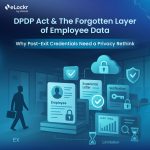In an intensely competitive job market, a strong resume can make the difference between getting an interview and getting overlooked. Unfortunately, this pressure drives some applicants to resort to resume fraud, embellishing or even fabricating work experiences, qualifications, and accomplishments. This dishonesty can have significant repercussions for employers, leading to poor hiring decisions, wasted resources, and even reputational damage.
In the fight against the persistent issue of resume fraud, digital technology offers a glimmer of hope: digital ex-employment verification. This innovative approach utilizes secure platforms to create tamper-proof records of an individual’s employment history. This shift towards digital verification promises to revolutionize the hiring landscape, ensuring a stronger foundation for informed and reliable hiring decisions.
The Problem of Resume Fraud
Resume fraud is more prevalent than you might think. Surveys routinely indicate that a substantial percentage of resumes contain some form of misrepresentation. Here are some common types of resume fraud:
Inflated job titles: Exaggerating previous job titles to appear more experienced or qualified.
Fabricated employment: Inventing entire job positions to fill gaps in employment history or cover up past terminations.
False credentials and degrees: Claiming educational qualifications or professional certifications that were never attained.
Copying Resumes or Cover Letters: Some people copy parts or all of another person’s resume or cover letter to make their own look better. They might copy exactly or use common templates that don’t really show what they can do.
The Consequences
The consequences of resume fraud can be significant for employers. Hiring unqualified candidates can lead to:
Productivity losses: Decreased productivity due to the hired individual’s lack of necessary skills or experience.
Poor morale: A sense of unfairness among colleagues who see unqualified individuals given unwarranted responsibilities or promotions.
Increased turnover: The unqualified employee may quit after realizing they are out of their depth, or they may need to be terminated, forcing the employer to start the hiring process all over again.
Reputational risks: In severe cases, hiring an unqualified candidate can lead to public embarrassment and damage trust in a company’s brand.
Traditional Verification Methods and Their Limitations
While many organizations do conduct some level of background and reference checks, traditional methods for verifying employment history can be time-consuming and unreliable.
Here’s why traditional methods often fall short:
Administrative burden: Contacting former employers and verifying information manually can be a lengthy and resource-intensive process.
Reference bias: Previous employers may provide incomplete or overly positive information or want to help a former employee secure a new role.
Difficulty verifying international experience: Obtaining employment information from companies in other countries can be particularly challenging, with language barriers and different data protection regulations adding complexity.
Vulnerability to forgery: Paper documents like offer letters and reference letters can be easily fabricated by sophisticated fraudsters.
How Digital Ex-Employment Verification Overcomes These Challenges
Digital ex-employment verification harnesses the power of cutting-edge technology to transform the employment verification landscape. Here’s how it operates:
Secure Credential Issuance: When an employee leaves a company, their employment data (job title, dates of employment, responsibilities, etc.) is packaged into a verifiable digital credential. This credential is cryptographically signed and issued by the former employer.
Credential Storage: The digital credential is stored on a secure, distributed platform like eLockr or digilocker. This ensures the information is tamper-proof and can’t be altered after the fact.
Candidate Consent: When a candidate applies for a job, they provide consent to prospective employers to access their verified employment credentials.
Instant Verification: Prospective employers can instantly verify the candidate’s credentials via a secure platform like eLockr . This removes the need for manual phone calls or emails to past employers.
Benefits of Digital Ex-Employment Verification
Enhanced security: Tamper-proof digital records created to make fraud significantly more difficult.
Speed and efficiency: Verification can be completed in minutes rather than the days or even weeks required for traditional methods.
Streamlined HR processes: Automating parts of the verification process frees up HR teams for more strategic tasks.
Accuracy and reliability: The risk of incomplete, inaccurate, or biased information is reduced, as employers access information directly from the source.
Improved candidate experience: Applicants who have honestly represented their work history benefit from a faster and more seamless hiring process.
Read also: Employment Verification Process – Learn Everything In 3 Minutes
Conclusion
The rise of digital ex-employment verification signifies a crucial step towards a more transparent and trustworthy hiring landscape. By adopting this technology, organizations can confidently assess candidates’ qualifications, protect themselves from costly mistakes, and ultimately make well-informed hiring decisions. While not a foolproof solution, digital ex-employment verification, coupled with other verification methods and comprehensive assessments, empowers employers to build strong and competent teams.
As this technology evolves and becomes more widely adopted, we can anticipate a future where both employers and employees can navigate the hiring process with greater confidence and peace of mind.





Leave a Reply